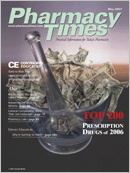Publication
Article
Pharmacy Times
Potential Drug Interactions in Smokers and Quitters
Cigarette smoke is known tocontain thousands of differentcompounds. Some of thesecompounds?including aromatic hydrocarbons,N-nitrosamines, and aromaticamines?have been noted to becarcinogenic.
In addition, cigarette smoking isknown to be an enzyme inducer. Theinduction of CYP1A1, an enzyme thatactivates procarcinogens in the lung, isthought to be a major mechanism leadingto the development of lung cancer.1Whereas CYP1A1 is not important forhuman drug metabolism, cigarettes alsoinduce the activity of CYP1A2, and to alesser extent CYP2E1 and some of theuridine diphosphate-glucuronosyl transferases?enzymes involved in the glucuronidationof drugs (Table2). The effectsof cigarettes on other drug-metabolizingenzymes are not well studied.
The most consistently observed effectof cigarettes on drug metabolism is anincrease in the clearance of drugs thatare substrates of CYP1A2. Selecteddrugs that interact with smoking are listedin the Table. Other common drugsmetabolized by CYP1A2 are duloxetine,erlotinib, frovatriptan, melatonin, mirtazapine,ondansetron, ramelteon, rasagiline,ropinirole, selegiline, tizanidine, triamterene,and warafin.
Secondhand Smoke
It may not be necessary to actually bea smoker to have one's metabolismincreased by smoking. A study of childrenexposed to secondhand smoke foundthat they had a 50% higher theophyllineclearance, compared with matched controlsnot exposed to smoke.3
Similarly, even limited smokingseems to be able to produce a measurableincrease in CYP1A2 activity. Arecent study compared olanzapine andclozapine dosage in smokers and nonsmokers.4 Although the mean dose ofthe 2 drugs was similar for smokersand nonsmokers, the nonsmokers hadserum concentrations that were 67%and 50% higher than smokers for olanzapineand clozapine, respectively.
Smoking as few as 7 to 12 cigarettesdaily produced the same magnitude ofinduction on drug metabolism assmoking more than 20 cigarettes daily.Thus, nonsmokers were more likely tohave higher blood levels of the drugsand to be at a higher risk of toxicity,compared with smokers.
Effects on Metabolism
This column has previously notedthe sensitivity of tizanidine to CYP1A2inhibitors.5 Indeed, the CYP1A2 inhibitorciprofloxacin (Cipro) recently wasnoted to interact with tizanidine.6 Onewould expect the metabolism of tizanidine(and the metabolism of otherCYP1A2 substrates) to be increased bysmoking.
As smoking-cessation therapy becomesmore successful, it is importantto be aware of patients taking drugsthat are likely to have their metabolisminduced during cigarette consumption.With the discontinuation of smoking,the metabolism of these agents will bereduced. This change is likely to begradual, making the onset of toxicitysomewhat slow, delayed, and difficultto evaluate.
Pharmacists should be alert for evidenceof excess drug effects as thesmoking-induced induction dissipates.Patients may require a gradual reductionin the dosage of chronic drugs that aresubstrates for CYP1A2 to avoid thedevelopment of side effects.
Drs. Horn and Hansten are both professorsof pharmacy at the Universityof Washington School of Pharmacy.For an electronic version of this article,including references if any, visitwww.hanstenandhorn.com.
References
1. Guengerich FP. Metabolic activation of carcinogens. Pharmacol Ther.1992;54:17-61.
2. Zevin S, Benowitz NL. Drug interactions with tobacco smoking. Clin Pharmacokinet. 1999;36:425-438.
3. Mayo PR. Effect of passive smoking on theophylline clearance in children. Ther Drug Monit. 2001;23:503.
4. Haslemo T, Eikeseth PH, Tanum L, Molden E, Refsum H. The effect of variablecigarette consumption on the interaction with clozapine and olanzapine. Eur J Clin Pharmacol. 2006;62:1049-1053.
5. Horn JR, Hansten PD. Interactive properties of tizanidine (Zanaflex). Pharm Times. 2006;72:24.
6. Momo K, Homma M, Kohda Y, Ohkoshi N, Yoshizawa T, Tamaoka A. Druginteraction of tizanidine and ciprofloxacin: case report. Clin Pharmacol Ther.2006;80:717-719.







